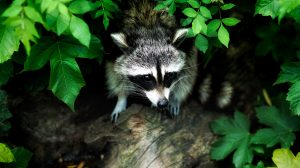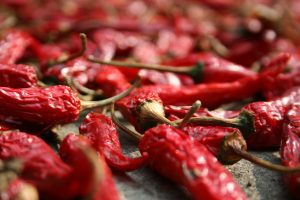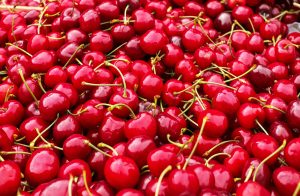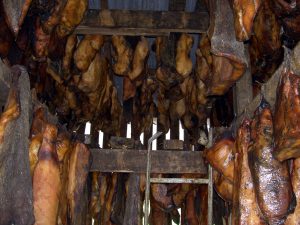Feeling peckish? Perhaps you'd like to sample a few of the most dangerous foods in the world. From spices to fruits, from exotic fish to roadkill, these are the most notable dishes and snacks from around the globe that ought to come with a warning label attacked.
Warning: you may not get the chance to come back for seconds.
 Photo by Matt Bero on Unsplash
Photo by Matt Bero on Unsplash
40. Roadkill
It sounds like a joke or an urban legend, but people do actually eat roadkill. And not just rednecks: it happens all over the world, sometimes even with the encouragement of local governments trying to cull surplus wildlife populations.
Of course, eating roadkill saves you money. But it may also be highly dangerous.
While a deer you hit with your car may be perfectly safe to eat, other forms of roadkill present a risk of parasites and communicable diseases. So, all in all, it's probably best not to get your dinner from the side of the road.
 Image by Roadkill: do not eat
Image by Roadkill: do not eat
39. Wild Mushrooms
There's something romantic about going for a hike and picking wild mushrooms for a snack. But unless you're an expert in fungi, you could be serving yourself up one of the world's most dangerous foods. There are just too many wild mushrooms that can kill you, particularly death caps.
 Image by Definitely don't eat this one -- that's a scarlet death cap
Image by Definitely don't eat this one -- that's a scarlet death cap
38. Pits
Plums, peaches, apricots -- any fruit with a stone pit is potentially poisonous. Pits of these fruits naturally contain cyanide, which... you know, will kill you in large enough quantities. The good news is that most of these fruits have pits so large you couldn't eat them if you wanted to.
 Image by Just the pits
Image by Just the pits
37. Bitter Almonds
Speaking of cyanide, you'll also find plenty in bitter almonds, easily making them one of the world's most dangerous foods. While sweet almonds are safe and delicious, bitter almonds can kill you. Each one contains 4-9 mg of hydrogen cyanide. That means 50 of these puppies could kill an average adult; 5-10 would be enough to kill an average child.
Don't worry: the almonds you buy at the store are exclusively sweet.
 Image by These are the sweet variety; you'd have to go looking for the bitter ones
Image by These are the sweet variety; you'd have to go looking for the bitter ones
36. Cassava
Cassava isn't popular in the U.S., but it's a staple in much of the world. It's a hardy root plant, able to grow even in harsh climates and borderline drought conditions. It's a key part of the diet of half a billion people. And it could also kill you if you don't prepare it just right.
Cassava flour needs to be mixed with water and left in the shade for at least five hours before consumption. That's because the root contains huge amounts of cyanide that need to evaporate before its byproducts are safe to eat.
 Image by Cassava root is key in the fight against starvation -- even though it's one of the most dangerous foods in the world
Image by Cassava root is key in the fight against starvation -- even though it's one of the most dangerous foods in the world
35. Cinnamon
Remember the cinnamon challenge? Viral videos of people eating raw cinnamon powder swept the dumber side of the internet a couple of years ago. However, the danger of such an activity is very serious. Accidentally inhaling cinnamon can be perilous indeed; potential complications include pneumonia, collapsed lungs, and a death.
 Image by Cinnamon: delicious in a bun, deadly in your lungs
Image by Cinnamon: delicious in a bun, deadly in your lungs
34. Nutmeg
Nutmeg is a popular spice, but in excessive quantities, it can definitely be dangerous. If you eat too much, you activate its psychoactive properties. The result can be convulsions, sweating, generalized pain, hallucinations, and even amnesia lasting several days. In extreme cases, nutmeg overdose can even lead to death.
 Image by Don't go too nuts with the nutmeg
Image by Don't go too nuts with the nutmeg
33. Blood Clams
Blood Clams are prized as a delicacy in East Asia, particularly in China, Japan, and Korea. Mostly they're delicious but be careful where you get them. If they're not purified correctly, they contain many toxins and pathogens that will leave you wishing you'd ordered something else.
 Image by At least there's no blood
Image by At least there's no blood
32. Chili Peppers
Chili peppers are the spice of life for many diners the world over. However, the chemical that gives them their flavor is also an irritant and potential toxin. The culprit is capsaicin. If consumed to excess, it can cause severe abdominal pain, nausea, vomiting, and fire poops. And you definitely don't want to get capsaicin in your eyes; some peppers are so full of the stuff that they can chemically burn your skin!
 Image by Chili peppers are delicious, but too much of a good thing...
Image by Chili peppers are delicious, but too much of a good thing...
31. Lima Beans
Lima beans make a surprising appearance on our list of most dangerous foods. I mean, what could be safer -- or, dare we say it, boring?
Unfortunately, lima beans contain linamarin, which our bodies decompose into hydrogen cyanide. Fortunately, if you cook lima beans sufficiently, you remove the linamarin. So just make sure to avoid them when they're raw or undercooked.
 Image by Lima beans are good people, as long as you cook them
Image by Lima beans are good people, as long as you cook them
30. Durian
Durian fruit is notoriously smelly. So much so that it's illegal to eat it on busses or in public spaces in Singapore. But who knew it was dangerous as well?
It turns out durian inhibits your body's ability to break down alcohol. The result is that several people have died after combining the stinky fruit with their favorite adult beverage. So if you must try it, don't go to the bar for a while afterward.
 Image by Durians: smelly and also dangerous
Image by Durians: smelly and also dangerous
29. Alfalfa Sprouts
Alfalfa sprouts are definitely healthy, so what gives? The risk here is that the same warm, moist conditions you need to grow alfalfa sprouts are also ideal for growing dangerous bacteria. That's why there have been several outbreaks of food-borne illnesses linked to alfalfa in recent years.
 Image by Fun fact: Alfalfa was also one of the Little Rascals
Image by Fun fact: Alfalfa was also one of the Little Rascals
28. Starfruit
The starfruit comes in two flavors: sour and sweet. While delicious, both types also contain caramboxin and oxalic acid (though there's more in the sour variety). These compounds are potentially deadly to anyone with kidney disease, so it's best to avoid starfruit if you're not in perfect renal health.
 Image by When you're a starfruit they let you do it
Image by When you're a starfruit they let you do it
27. Cherries
Like other fruits with pits, cherries can be dangerous. The reason is that their pits contain hydrogen cyanide. You definitely don't want to swallow these, but the bigger risk is probably your furry friend getting into them. Dispose of your pits, people!
 Image by Cherries: delicious on the outside, poison on the inside
Image by Cherries: delicious on the outside, poison on the inside
26. Elderberries
When properly prepared, elderberries are not only safe to eat, but may offer considerable health benefits. But you definitely don't want to pick them and eat them when you get hungry on a hike.
Raw elderberries contain toxic cyanogenic glycosides that can make you extremely ill if consumed in sufficient quantities. The branches, leaves, and roots of elderberry plants are similarly toxic.
 Image by "Your mother was a hamster and your father smelt of elderberries!" - Monty Python
Image by "Your mother was a hamster and your father smelt of elderberries!" - Monty Python
25. Castor Beans (And Castor Oil)
Castor beans contain the deadly toxin ricin, which suffices to make it one of the most dangerous foods in the world. The oil extraction process gets rid of the ricin, but castor oil remains rather dangerous and unpleasant. Fascist thugs would often force victims to drink castor oil in Mussolini's Italy. The resulting dehydration was sometimes fatal.
 Photo by CDC on Unsplash Thanks for that nifty label, guys
Photo by CDC on Unsplash Thanks for that nifty label, guys
24. Rhubarb
Rhubarb stalks make splendid pies. However, you must never eat the leaves. These contain oxalic acid, which is toxic to humans. This caused serious problems during WWI, when the British government mistakenly suggested that people should eat rhubarb leaves to supplement their heavily-rationed diets.
 Photo by Markus Spiske on Unsplash The beautiful (but poisonous) rhubarb plant
Photo by Markus Spiske on Unsplash The beautiful (but poisonous) rhubarb plant
23. Peanuts
Peanuts are delicious and have given the world much joy. However, peanut allergy is one of the most common and deadly in the world. Concern about anaphylactic reactions has led many authorities to ban peanut products in public places in recent decades.
22. Honey
Don't worry: the honey you buy at the supermarket is plenty safe (unless you have diabetes). But raw, unpasteurized honey, while it may sound "organic" and "natural" is actually very dangerous. It may contain the Clostridium botulinum bacteria, which causes botulism. So, yeah... pasteurize your honey.
 Photo by Arwin Neil Baichoo on Unsplash Oh, honey, honey
Photo by Arwin Neil Baichoo on Unsplash Oh, honey, honey
21. Ackee
Ackee is a red fruit native to West Africa but popular in Caribbean cuisine. It's delicious and nutritious, but when unripe... it can be a killer. The fruit contains a family of toxins called hypoglycins, which are potentially deadly when ingested. Fortunately, the poison is only present in unripe ackee and in certain inedible parts of the fruit. When properly prepared, it's perfectly safe to eat.
 Image by Ackee and saltfish is the national dish of Jamaica
Image by Ackee and saltfish is the national dish of Jamaica
20. Tuna
This one is our fault. With mercury levels in our oceans rising, tuna has become less safe to eat than ever. The mercury gets passed up the food chain and can ultimately end up on your plate. Excessive exposure to mercury can cause kidney problems, deterioration of intelligence, and even madness.
 Photo by Taylor Grote on Unsplash Tuna is delicious, but we're ruining it
Photo by Taylor Grote on Unsplash Tuna is delicious, but we're ruining it
19. Bean Sprouts
Bean sprouts are another healthy item you wouldn't expect to find on the list of the world's most dangerous foods. They're mostly dangerous because some people don't prepare them correctly. You can't just toss them on top of your stir-fry last minute, or eat them raw for a vegetarian snack. Bean sprouts are often teeming with dangerous bacteria, so if you don't cook them sufficiently... you could be in for a rough time.
 Image by Boil those sprouts before you eat them
Image by Boil those sprouts before you eat them
18. Potatoes
Fried green tomatoes are delicious; friend green potatoes... not so much. That's where the danger of this otherwise cheap and filling starch comes into play. If your potato is still green, that means it contains chlorophyll. Where there's chlorophyll, there's solanine, a toxin related to the deadly nightshade.
So if your potato has a greenish hue... steer clear!
 Image by Green garnish, on the other hand, is just fine
Image by Green garnish, on the other hand, is just fine
17. Cashews
Cashews are one of the world's most popular and (regrettably) rare nuts. Unfortunately, they can also be one of the most dangerous foods too.
Before they can be eaten, cashews absolutely must be boiled. Raw cashews contain urushiol, the same toxin that makes a brush with poison oak or poison ivy so unpleasant. If you ingest raw cashews, the results can be deadly.
Don't worry: no grocery store in the U.S. will sell you raw cashews.
16. Casu Marzu
Now we're getting a little gross. Casu marzu is a type of Sardinian cheese that has a little something extra for you. Larvae (AKA maggots) are intentionally introduced to the cheese to help in the fermentation process. That's right: it's a cheese that is intentionally eaten with maggots in it.
The health risks are obvious. But one particularly grisly possibility is that the larvae survive you eating them and take up residence in your stomach. This is one of the reasons cazu marzu has been outlawed.
 Photo by Jez Timms on Unsplash We're not showing a picture of that, so here's a nice sharp blue
Photo by Jez Timms on Unsplash We're not showing a picture of that, so here's a nice sharp blue
15. Larb
Larb is a sort of meat salad and the official dish of Laos in Southeast Asia. The danger here is that some forms of larb are served raw. The risks of eating raw meat are no surprise: roundworms, flatworms, other parasites, or even rabies.
 Takeaway/Wikimedia Raw beef larb
Takeaway/Wikimedia Raw beef larb
14. San-Nakji
Let's get gross again. San-nakji is a Korean dish comprised of recently-dead raw octopus. Although the octopi are deceased, continuing nerve activity often causes their tentacles to wriggle on the plate.
This is also what lands san-nakji on the list of most dangerous foods. Sometimes the writhing tentacles can suction themselves onto the throats of the people eating them. The result can be an unpleasant choking incident. Imagine being killed by something that's already dead!
 LWY/Wikimedia Be grateful we didn't include video!
LWY/Wikimedia Be grateful we didn't include video!
13. Hákarl
Ever wondered what fermented, rotting shark tastes like? Like urine. Wanna try it? Then head over to Iceland for some hákarl. It's made of Greenland sharks, whose flesh is actually poisonous. But don’t worry: the toxins seep out during the fermenting process. Or at least, they are if it's done correctly. If not... you'll get more than a bad taste in your mouth.
 Chris 73 / Wikimedia Commons Hakarl, fermented Icelandic shark meat.
Chris 73 / Wikimedia Commons Hakarl, fermented Icelandic shark meat.
12. Silver-Stripe Blaasop
The silver-stripe blaasop is considered a delicacy in some corners of the Indian Ocean. However, it's deadly if improperly prepared. The liver, skin, and reproductive systems of the blaasop are all toxic to humans and can cause respiratory failure if the chef fails to remove them.
11. Monkey Brains
It's unclear how common it is for humans to eat monkey brains in the modern world. Part of the difficulty in assessing this is the huge amount of urban legend that surrounds the practice. Nevertheless, it's definitely not a great idea. Eating the brains of monkeys or apes is a great way to get degenerative brain diseases like Creutzfeldt–Jakob disease.
 Image by Again, we're not showing that, so here's an adorable monkey eating a wafer
Image by Again, we're not showing that, so here's an adorable monkey eating a wafer
10. Giant African Bullfrog
Giant bullfrogs are considered a delicacy in Namibia. We normally recommend trying the local cuisine, but in this case, you would also be trying one of the world's most dangerous foods. These frogs have enough toxins in their skin to shut down your kidneys if they're not prepared with care.
 David J. Stand/Wikimedia This bullfrog bites back
David J. Stand/Wikimedia This bullfrog bites back
9. Echizen Kurage
Echizen kurage is made from Nomura's jellyfish. Like most jellyfish, this species is venomous, with attacks on humans becoming more common in recent years. Echizen kurage is considered a delicacy, but the dish can wind up poisoning you if all the jellyfish's stingers aren't removed.
The dish is popular enough in Japan that it has even been turned into an ice cream flavor.
 I, KENPEI/Wikimedia Nomura's jellyfish: dinner?
I, KENPEI/Wikimedia Nomura's jellyfish: dinner?
8. Pangium Edule
Pangium edule trees are native to Southeast Asia. Their fruit can be eaten, and indeed it's an important spice in many dishes. But boy, you'd better prepare it right. Otherwise, you're basically eating a cyanide capsule.
The seeds must be boiled, and buried in ash and banana leaves for forty days prior to human consumption.
 Midori/Wikimedia Pangium edule seeds, ready to be used in an Indonesian kitchen
Midori/Wikimedia Pangium edule seeds, ready to be used in an Indonesian kitchen
7. Fesikh
Fesikh is a small fish typically eaten as a form of spring celebration in Egyptian culture. The traditional preparation is fairly elaborate and involves sun-drying and then salting the fish. If done improperly, the result can be contamination. People in Egypt take ill from poorly-prepared fesikh every year, so make sure your host knows what they're doing!
 Faris Knight/Wikimedia Fesikh is eaten as part of the Sham el-Nessim festival in springtime
Faris Knight/Wikimedia Fesikh is eaten as part of the Sham el-Nessim festival in springtime
6. Sugar
Maybe you think this is a cop-out, but sugar has definitely killed more people prematurely than any of the other most dangerous foods. Our consumption of this crop has exploded in the last 500 years, to the detriment of our health.
"When Elizabeth I ruled England in the fifteenth century," historian Paul Freedman told Gizmodo, "the average person ... ate little more than a pound of sugar a year -- it was a luxury product. Presently ... in the U.S., it’s more than 125 pounds."
 Image by The most dangerous thing on this list -- hands down
Image by The most dangerous thing on this list -- hands down
5. Absinthe
Absinthe is one of the strongest and most dangerous liquors in the world. If you're trying it for the first time... treat it with respect. It's typically 45-70% alcohol. It is commonly said to have psychoactive properties that make it more dangerous and addictive than other drinks. However, this remains unsubstantiated and may be due to absinthe's association with French artists and intellectuals of the late 19th and early 20th centuries.
 Image by Item #5 on this list is typically poured through a cube of #6 (sugar)
Image by Item #5 on this list is typically poured through a cube of #6 (sugar)
4. Hot Dogs
Yes, hot dogs. Hot dogs are a major choking hazard -- the leading one among children, as it turns out. It's the perfect size and shape to block a human windpipe, and hard to dislodge once it's in there.
3. Fugu
Fugu is famously one of the most dangerous dishes in the world. It's a type of pufferfish that's considered a delicacy in Japan. The only problem is that its body is loaded with deadly tetrodotoxins. Specially trained chefs must remove all the poisonous parts of the fish before humans can eat it. Oh, and by the way: there's no known antidote.
This is why fugu is often called foodie Russian roulette.
 Image by A dish of fugu prepared correctly... we hope...
Image by A dish of fugu prepared correctly... we hope...
2. Gutter Oil
Gutter oil is exactly what it sounds like. In China, criminals retrieve cooking oil from gutters, repackage it, and sell it to cheap restaurants where it is used to cook meals for unsuspecting customers. If you eat at a budget restaurant in China, there's a 1 in 10 chance your meal contains gutter oil.
Immediate health effects include extreme abdominal pain, nausea, and diarrhea. But longer-term exposure may cause stomach and liver cancer.
Gutter oil is easily one of the most dangerous foods in the world.
 Photo by Daria Nepriakhina on Unsplash You may not want to know where your oil comes from
Photo by Daria Nepriakhina on Unsplash You may not want to know where your oil comes from
1. Bushmeat
Bushmeat is also exactly what it sounds like: it's random wildlife hunted out in the bush. It's an important source of food for hundreds of millions of poor people in tropical countries. But if you're visiting, do not try it.
Eating arbitrary jungle meat is a great way to get tuberculosis, leprosy, cholera, measles, HIV, countless parasites, and even ebola. It's theorized that bushmeat is where many of these diseases originated in the first place.
 Wikiseal/Wikimedia Smoked bushmeat: better than raw bushmeat at least
Wikiseal/Wikimedia Smoked bushmeat: better than raw bushmeat at least











